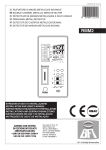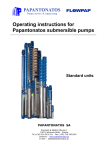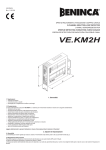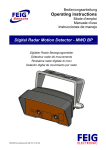Download Operating instructions Traffic detector VEK M2E-2
Transcript
Operating instructions Traffic detector VEK M2E-2 FEIG ELECTRONIC GmbH Lange Straße 4 35781 Weilburg/Lahn VEK M2E-2 © Copyright 1998 by Operating instructions FEIG ELECTRONIC GmbH Lange Straße 4 D - 35781 Weilburg The indications made in these operating instructions may be altered without previous notice. With the edition of these instructions, all previous editions become void. Composition of the information given in this manual has been done to the best of our knowledge. FEIG ELECTRONIC does not guarantee the correctness of the details given in these instructions and may not be held liable for damages ensuing from incorrect installation. Since, despite all our efforts, errors may not be completely avoided, we are always grateful for your useful tips. The installation instructions given in this manual are based on advantageous boundary conditions. FEIG ELECTRONIC does not give any guarantee promise for perfect function of the appliance in a cross surrounding. Copy or reproduction of these instructions, even if only partial, as well as translation into other languages is forbidden unless a written consent has been granted by FEIG ELECTRONIC. This also applies to the complete or partial storage of these operating instructions on modern input- and output media for further processing in data processing systems. Please read the operating- and safety instructions thoroughly before putting the appliance into operation ! Issue: 02.03.06 as Bes-m2e_UK.doc 2 03/06 FEIG ELECTRONIC GmbH Operating instructions VEK M2E-2 Contents 1. General............................................................................................................... 4 2. Adjustment possibilities ...................................................................................... 5 2.1. Sensitivity.............................................................................................. 5 2.2. Frequency ............................................................................................. 5 2.3. Holding time .......................................................................................... 5 2.4. Output function...................................................................................... 6 2.4.1. Presence detection.................................................................. 6 2.4.2. Directional detection ................................................................ 6 2.5. Readjustment (Reset) ........................................................................... 8 3. Outputs and LED-display.................................................................................... 9 3.1. Working principle of the relays .............................................................. 9 3.2. Contact conditions of the relays ............................................................ 9 3.3. Loop failure ........................................................................................... 9 3.4. Diagnostic plug ..................................................................................... 10 3.5. LED-display........................................................................................... 10 3.6. Output of loop frequency....................................................................... 10 4. Technical data .................................................................................................... 11 5. Operating elements and connections ................................................................. 12 6. Housing dimensions ........................................................................................... 13 7. Installation and initiation ..................................................................................... 13 8. Device categories ............................................................................................... 14 8.1. Type VEK M2E-2 -B.............................................................................. 14 8.2. Type VEK M2E-2 -D ............................................................................. 14 8.3. Type VEK M2E-2 -E.............................................................................. 15 9. Safety instructions .............................................................................................. 17 FEIG ELECTRONIC GmbH 03/06 3 VEK M2E-2 Operating instructions 1. General The induction loop detector is a system used for inductive vehicle detection. Range of application: • Barrier controls • Door- and gate controls • Parking- and traffic engineering Characteristic features: • evaluation of two loops • galvanic separation of loop and detector electronics • automatic system adjustment directly after switch-on • continuous rebalancing of frequency drifts in order to avoid environmental influences • suitable for individual job control • no influence on loop 1 and loop 2 through multiplexing • sensitivity adjustment independent of loop inductivity • occupied-signal emitted by LED-display • potential-free relay contacts as outputs • Relay triggering may be converted from static current- to operating current principle by switch operation. • loop breach- or loop closing message via LED-signal • indication of occurred and eliminated loop failures • indication of base frequency by flash signals of the green LED • diagnosis by external diagnostic device • 11-pole circular connector Possibilities of adjustment: • two frequency levels to be used by both channels • four sensitivity levels per channel • Holding time: 5 minutes or infinite for both channels • presence- or directional detection • permanent- or pulse signal for relay channel 2 • permanent direction signal or pulse direction signal l Structural shape: • Housing 76x38x71mm (HxWxL) with 11-pole circular connector, RAL 5005 • 2 boards, 72x65mm each For planning and installation of induction loops, please refer to our manual „vehicle detection with the induction loop detector“. 4 03/06 FEIG ELECTRONIC GmbH Operating instructions VEK M2E-2 2. Adjustment possibilities 2.1. Sensitivity By adjusting the sensitivity for each channel, we determine, which change of inductivity a vehicle has to cause in order to set the detector’s output. Sensitivity adjustment is done separately for each channel in 4 levels and according to the dual system, with 2 DIP-switches. Adjustment for channel 1 is done with DIP-switches 1and2 and for channel 2 with DIP-switches 3 and 4. Channel 1 DIP-switch 1 Sensitivity level 2 Channel 2 DIP-switch 3 4 1 low (0,64% ∆f/f) OFF OFF OFF OFF 2 (0,16% ∆f/f) ON ON 3 (0,04% ∆f/f) OFF ON OFF ON 4 high (0,01% ∆f/f) ON ON OFF ON OFF ON 2.2. Frequency The detector’s working frequency may be selected in two common levels, to be used for both channels. The admissible frequency range is 30kHz to 130kHz. The frequency depends on the loop geometry, number of turns, loop supply line and the chosen switch position. One common frequency may be adjusted for both channels with DIP-switch 5. DIP-switch 5 ON OFF Frequency level High Low 2.3. Holding time The common holding time for both channels may be adjusted with DIP-switch 6. DIP-switch position 6 OFF ON Holding time 5 minutes Infinite After the holding time has expired, the "loop free" signal is indicated and the loops will be automatically readjusted. The holding time of a detector channel starts with the assignment of the respective loop. FEIG ELECTRONIC GmbH 03/06 5 VEK M2E-2 Operating instructions 2.4. Output function 2.4.1. Presence detection For the presence detection mode, you have to put DIP-switch 7 in "OFF" position. The output signal for the relay at channel 2 is selected with the help of DIP-switch 8, while a permanent signal is emitted at relay 1 for channel 1. Output signal channel 2 / relay 2 Permanent signal Pulse when vehicle leaves loop 2 DIP-switch position 8 OFF ON 2.4.2. Directional detection (not for all types; see 8. Device categories) If DIP-switch 7 is "ON", two directional logics will be supported in dependence on DIP-switch 8. The directional pulse is mainly used in counting devices, whereas the permanent direction signal is used for requests in gate- and barrier control units. In the following, we will explain the function of the directional logic, taking loops 1 and 2 with direction of motion 1Æ2 as an example. The direction signal is emitted by the relay of the loop that the vehicle crosses first. This means that the signal will be indicated by relay 1 if the direction of motion is 1Æ2 . a) Single vehicle 1 2 DIP-switch 8 "ON" pulse signal DIP-switch 8 "OFF" permanent signal Relay 1 Æ directional pulse Relay 1 Æ permanent direction signal 'on' Ð 1 2 Ð 1 2 Ð 1 Relay 1 Æ permanent direction signal 'remains' 2 Ð 1 6 Relay 1 Æ permanent direction signal 'off' 2 03/06 FEIG ELECTRONIC GmbH Operating instructions VEK M2E-2 b) Queue traffic 1 2 DIP-switch 8 "ON" pulse signal DIP-switch 8 "OFF" permanent signal Relay 1 Æ directional pulse Relays 1 Æ permanent direction signal 'on' Ð 1 2 Ð 1 2 Ð 1 Relay 1 Æ permanent direction signal 'remains' 2 Ð 1 Relay 1 Æ permanent direction signal 'remains' 2 Ð 1 2 Ð 1 Relay 1 Æ permanent direction signal 'off' Relay 1 Æ directional pulse 2 Ð 1 Relay 1 Æ permanent direction signal 'remains' 2 Ð 1 Relay 1 Æ permanent direction signal 'off' 2 FEIG ELECTRONIC GmbH Relay 1 Æ permanent direction signal 'on' 03/06 7 VEK M2E-2 Operating instructions c) Vehicle rolling back 1 2 DIP-switch 8 "ON" pulse signal DIP-switch 8 "OFF" permanent signal Relay 1 Æ directional pulse Relay 1 Æ permanent direction signal 'on' Ð 1 2 Ð 1 2 Ð 1 2 Ð 1 Relay 1 Æ permanent direction signal 'off' 2 Relay 2 Æ directional pulse indicates vehicle is rolling back The evaluation of the direction signal in opposite direction of motion is done in the same way. In case of a loop breach resp. closing, the system switches over to the presence detection mode for the time of the failure. A permanent signal is now emitted by the relay of the intact loop channel as soon as the loop is occupied. 2.5. Readjustment (Reset) The detector automatically carries out a loop frequency adjustment as soon as the power supply is switched on. In case of a short-term voltage loss <0,3s, no readjustment will be carried out; conditions remain stored. A readjustment may be triggered manually by pressing the reset key. If the loop frequency is stable, the adjustment time is approx. 1s. If the loop is occupied during this adjustment phase, the adjustment time will be extended accordingly. In case that the loop is permanently occupied during the adjustment process, the detector will be readjusted as soon as the vehicle has left the loop. Due to this, the following vehicles will again be detected. Longer adjustment times hint to an unstable loop frequency. The loop/detector system has to be checked with regard to possible interferences. 8 03/06 FEIG ELECTRONIC GmbH Operating instructions VEK M2E-2 3. Outputs and LED-display 3.1. Working principle of the relays The detector has a potential-free relay contact at each output. The static current- or operating current principle may be selected for each channel with the help of a slide switch. Switch Position right Static current principle (Relay coil falls off during signal output) left Operating current principle (Relay coil attracts during signal output) 1 2 1 2 Working principle 3.2. Contact conditions of the relays (For device categories, please refer to chapter 8) The following chart illustrates the relay’s condition depending on the selected relay working principle and the detector condition. Detector condition Loop is free Loop is occupied Loop failure Reset Voltage off 3.3. Loop failure In case of a loop failure, the relay of the disturbed channel changes into the „loop is occupied“ condition. The green LED goes out. The red LED lights up. After the fault has been eliminated, the detector channel keeps on working independently. The green LED pulsates now, in order to hint to the fault which has occurred and already been eliminated. This fault indicator is restored by pressing the reset key. FEIG ELECTRONIC GmbH 03/06 9 VEK M2E-2 Operating instructions 3.4. Diagnostic plug For an optimum adjustment of the detector, please connect diagnostic device VEK FG2. Diagnostic device VEK FG2 indicates all relevant data for initiation and service. It provides information on the loop/detector system, so that we may then optimise the adjustments as well as localise the cause for malfunctions. For further information, please refer to the operating instructions of diagnostic device VEK FG2. Warning: please only plug in the diagnostic cable when the detector is idle ! 3.5. LED-display The green LED indicates that the detector channel is ready for operation and sends out important hints regarding initiation of the detector (failure, adjustment, frequency output) via flash signals. The red LED indicates activation of the relay output in dependence on the availability condition of the loop. Green LED Loop control Off Red LED Loop condition off Flashes flashes after adjustment On off off On on Off Pulsates on off Pulsates on Detector condition Reset or Lack of supply voltage Adjustment Loop frequency output Detector ready, loop free Detector ready, loop occupied Loop failure Loop free, after temporary failure Loop occupied, after temporary failure 3.6. Loop frequency output After the detector has been readjusted, the loop frequency is indicated by flash signals of the green LED. Approx. 1s after the successful readjustment, the output starts with the 10kHzposition of the frequency value. The green LED of the detector channel will flash 1 time per 10kHz loop frequency. After a 1s break, the 1kHz-position will be indicated in the same way. In case that the units digit has the valency '0', 10 flash signals will be emitted. The duration of the flash signals of the 1kHz-position is a little shorter than the one of the 10kHz- position. Example of a 57kHz loop frequency: Zehner Einer 1s 5x 10kHz 7x 1kHz entspricht: 57kHz If both channels are adjusted at the same time, the frequency of channel 1 is indicated before channel 2. 10 03/06 FEIG ELECTRONIC GmbH Operating instructions VEK M2E-2 4. Technical data Structural shape of housing Protective system Supply voltage Power consumption Protection class 76 x 38 x 71 mm (HxBxL), Ral 5005 with 11-pole circular connector IP 40 230V +10%/-15%, 50/60Hz transformer is short circuit-proof acc. to VDE 0551 max. 3 VA II Admissible working temperature Storing temperature Air moisture -20 °C to +70 °C Loop inductivity Frequency range Responsiveness Holding time 20-700 µH 30-130 kHz in 2 common levels for both channels 0,01 % to 0,65 % (∆f/f) in 4 levels per channel 0,02 % to 1,3 % (∆L/L) 5 min. or infinite, for both channels Loop supply line Loop resistance < 250 m < 20 Ohm (incl. supply line) -40 °C to +70 °C < 95 % non-thawing Break-contact (make-contact for type -E) 250V AC, 4A, 1000 VA (resistive load AC) Minimum contact load 0,25mW/10mV/1mA Operating-/static current principle may be selected with switch Testing voltage coil-contact 4000V AC Contact-contact 1000V AC Duration of signal, pulse time > 200 ms 80 ms Cycle time 160 ms Reaction time Limit speed for presence 100 km/h detection 90 km/h at a loop head distance of 2m 45 km/h at a loop head distance of 1m Directional detection Relay Diagnosis 10-pole diagnostic socket for 'VEK FG2' Connection 11-pole circular connector CE-relevant standards prEN 50082-2, Nov. 1994 resistance to jamming (Industrial buildings) EN 50081-1, March 1993 interference output (domestic buildings) Other standards EN 61010-1, March 1994 low tension guideline (excess-voltage category II, pollution level 2) FEIG ELECTRONIC GmbH 03/06 11 VEK M2E-2 Operating instructions 5. Operating elements and connections Front view: VEK M2E 1 2 3 4 5 6 7 8 1 Empfindlichkeit Kanal 1 2 F H 5min. Empfindlichkeit Kanal 2 Frequenz low / high Haltezeit 5min / unendlich Richtungslogik aus / ein Dauersignal / Impulssignal Service 1 Schleifenzustand / Schleifenkontrolle Kanal 1 2 Schleifenzustand / Schleifenkontrolle Kanal 2 1 Schalter Arbeits- / Ruhestromprinzip Kanal 1 Schalter Arbeits- / Ruhestromprinzip Kanal 2 2 Reset Contact assignment 11-pole connector plug: (see also: device categories, chapter 8) 230V L 50-60Hz N PE 12 1 2 9 2 3 4 1 5 6 1 7 8 2 10 11 Notice: Relay contacts are pictured in idle condition ! Mixed operation of extra-low- and low voltage at the relays is not admitted ! ( e.g. 24VDC at relay 1 and 230VAC at relay 2 ). The durability of the relay contacts is increased by external, parallel connected RC modules (e.g. 100Ohm/10nF)! 03/06 FEIG ELECTRONIC GmbH Operating instructions VEK M2E-2 6. Housing dimensions Dimensioned drawing: 7. Installation and initiation • • • • • • Mixed operation of extra-low/low voltage at the relays is not admitted (e.g. 24VDC at relay 1 and 230V AC at relay 2) ! The isolation of the connection cables has to be suitable for 230V ! In order to set the loop/detector system into operation, the adjustments ‚presence detection‘ (DIP-switch 7 ‚OFF‘) and ‚permanent signal‘ (DIP-switch 8 ‚OFF‘) should be selected at detector VEK M2E. The perfect functioning of detector and relay outputs may be checked by seizing the loops. After having passed the test successfully, you may switch over to directional detection resp. pulse signal output. When selecting the frequency level, please keep a frequency distance of approx. 15 kHz to the loop frequency of a neighbouring detector. The sensitivity level should only be chosen as high as necessary. It has to be adjusted to the loop geometry and to the object to be detected. The device is intended for installation in a switch cabinet. The switch cabinet has to have a continuous base isolation. Installation of this device outside a switch cabinet-like housing is not admitted. FEIG ELECTRONIC GmbH 03/06 13 VEK M2E-2 Operating instructions 8. Device categories In the following, we will deal with the differences between the various types in comparison to standard model VEK M2E-2-A. 8.1. Type VEK M2E-2 -B Contact assignment type VEK M2E-2-B: 230V L 50-60Hz N PE 1 2 9 Notice: Relay contacts are pictured in idle condition ! 1 3 4 No mixed operation of extra-low- and low voltage at the relays! ( e.g. 24VDC at relay 1 and 230VAC at relay 2 ). 2 5 6 The durability of the relay contacts may be increased by external, parallel connected RC modules (e.g. 100Ohm/10nF)! 2 7 8 1 10 11 8.2. Type VEK M2E-2 -D Front view of type VEK M2E-2-D: VEK M2E 1 2 3 4 5 6 7 8 1 Empfindlichkeit Kanal 1 2 F H 5min. Empfindlichkeit Kanal 2 Frequenz low / high Haltezeit 5min / unendlich Relaisverriegelung aus / ein Dauer- / Impulssignal (Sperrzeit 10s / 5s) Service 1 2 1 Schleifenzustand / Schleifenkontrolle Kanal 1 2 Schleifenzustand / Schleifenkontrolle Kanal 2 Schalter Arbeits- / Ruhestromprinzip Kanal 1 Schalter Arbeits- / Ruhestromprinzip Kanal 2 Reset 14 03/06 FEIG ELECTRONIC GmbH Operating instructions VEK M2E-2 Relay locking: (only for type VEK M2E-2-D) Relay locking is activated as soon as DIP-switch 7 is in "ON" position. In this mode, presence is indicated by the relay of the loop which has been occupied first. The signal output of the other channel remains locked until both loops have been crossed or the timeout has expired. DIP-switch 7 OFF ON Output function Presence detection Relay locking Time-out: (only for type VEK M2E-2-D) The time-out is selected in the output mode relay locking, with the help of DIP-switch 8. In case of presence detection, it can be used to choose the signal output for channel 2. DIP-switch 8 Output function Presence detection Relay locking Permanent signal during Time-out 10s presence on loop 2 for both channels Pulse when leaving loop 2 Time-out 5s for both channels OFF ON 8.3. Type VEK M2E-2 -E Directional logic type VEK M2E-2-E: a) single vehicle 1 2 DIP-switch 8 "ON" pulse signal DIP-switch 8 "OFF" permanent signal Ð 1 2 Ð 1 Relay 1 Æ permanent direction signal 'on' 2 Ð 1 2 Relay 1 Æ directional pulse Relay 1 Æ permanent direction signal 'remains' Ð 1 Relay 1 Æ permanent direction signal 'off' 2 FEIG ELECTRONIC GmbH 03/06 15 VEK M2E-2 Operating instructions Evaluation of the direction signal in the opposite direction is done in the same way. In case of a loop break resp. –closing, the system switches to the presence detection mode for the time of the failure. A soon as the loop is occupied, a permanent signal will be emitted by the relay of the intact loop channel. Contact assignment type VEK M2E-2-E: 230V 50-60Hz L N 1 2 1 3 4 2 5 6 2 9 7 8 1 10 11 Notice: Relay contacts are pictured in idle condition ! No mixed operation of low- and extra-low voltage at the relays ! ( e.g. 24VDC at relay 1 and 230VAC at relay 2 ). The durability of the relay contacts may be increased by external, parallel connected RC-modules (e.g.. 100Ohm/10nF)! Contact conditions type VEK M2E-2-E: Channel 1 Channel 2 Detector condition 9 7 9 7 Loop is free 8 9 8 7 9 7 Loop is occupied 8 Loop failure, readjustment 9 *) 8 7 9 7 *) 8 9 8 7 9 7 Reset 8 9 8 7 9 7 Voltage off 8 8 *) In case of presence detection, an inverted signal is emitted for this detector condition at channel 1! Some important hints regarding type VEK M2E-2-E: • • • 16 No indication of the loop frequency by flash signals of the green LED ! In case of a loop failure, the green LED of the disturbed channel will flash in short intervals ! In „presence detection“ position, the red LED will light up during a loop failure or readjustment of channel 1! 03/06 FEIG ELECTRONIC GmbH Operating instructions VEK M2E-2 9. Safety instructions • • • • • • • • • • • • • • The device may only be used for the purpose intended by the manufacturer. The operating instructions have to be handed out to every user and kept in an easily accessible place. Unacceptable changes as well as the use of spare parts and special features which are not sold or recommended by the manufacturer, may cause fire, electric shocks and injuries. Therefore, such measures lead to nonliability of the manufacturer and a lapse of all warranty claims. The appliance is subject to the manufacturer’s guarantee regulations in the version valid at the time of purchase. We cannot be held liable for improper or faulty manual or automatic adjustment of parameters resp. improper use of the appliance. Repair work may only be carried out by the manufacturer. Installation, initiation, maintenance, measuring and adjustment of the traffic detector should only be carried out by electricians with a good knowledge of the rules for prevention of accidents. When handling appliances that get in contact with electricity, the valid VDE-regulations have to be observed. In particular, these are: VDE 0100, VDE 0550/0551, VDE 0700, VDE 0711, VDE 0860, VDE 0105 as well as the rules for the prevention of accidents and fire, VBG4. If an operation display goes out, this is not a proof that the appliance is disconnected from the mains and idle. All labour that is carried out on the appliance as well as its initiation, has to conform to the national as well as the local electric regulations. The user has to make sure that the appliance is installed and operated according to the technical rules of the country of installation as well as other regional regulations. Cable dimensions, protection, grounding, disconnection, insulation control and excess current protection should be especially considered. Mixed operation of low- and extra-low voltage at the two relay outputs is not admitted. The isolation of all connecting cables to the 11-pole circular connector has to be suitable for 230V. The circular connector conforms to the base isolation. The diagnostic cable of the diagnostic unit VEK FG2 as well as the cover of the diagnostic socket should only be plugged in resp. removed if the traffic detector is idle. As soon as the diagnostic procedure is terminated, the cover has to be put back into place. According to machine directive 89/392/EWG, appendix IV, the appliance must not be used as a safety component. Systems with a high danger potential need additional safety contrivances ! FEIG ELECTRONIC GmbH 03/06 17 VEK M2E-2 Operating instructions Notes: 18 03/06 FEIG ELECTRONIC GmbH




























